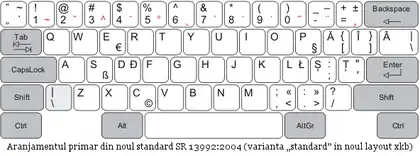Romanian keyboard layout
The current Romanian National Standard SR 13392:2004 establishes two layouts for Romanian keyboards: a "primary" one and a "secondary" one.


The “primary” layout is intended for more traditional users that learned long ago how to type with older, Microsoft-style implementations of the Romanian keyboard. The “secondary” layout is mainly used by programmers and it does not contradict the physical arrangement of keys on a US-style keyboard. The “secondary” arrangement is used as the default one by the majority of GNU/Linux distributions.
There are four Romanian-specific characters that are incorrectly implemented in all Microsoft Windows versions before Vista:
- U+0218 Ș LATIN CAPITAL LETTER S WITH COMMA BELOW – incorrectly implemented as U+015E Ş LATIN CAPITAL LETTER S WITH CEDILLA
- U+0219 ș LATIN SMALL LETTER S WITH COMMA BELOW – incorrectly implemented as U+015F ş LATIN SMALL LETTER S WITH CEDILLA
- U+021A Ț LATIN CAPITAL LETTER T WITH COMMA BELOW – incorrectly implemented as U+0162 Ţ LATIN CAPITAL LETTER T WITH CEDILLA
- U+021B ț LATIN SMALL LETTER T WITH COMMA BELOW – incorrectly implemented as U+0163 ţ LATIN SMALL LETTER T WITH CEDILLA
Since Romanian hardware keyboards are not widely available, Cristian Secară has created a driver that allows the Romanian characters to be generated with a US-style keyboard, in all Windows versions previous to Vista. It uses the right AltGr key modifier to generate the characters.[1]
Legacy QWERTZ Windows keyboard
_Keyboard.svg.png.webp)
Before Windows Vista, this keyboard layout was the default for Romanian. From Vista onwards, its name is „Romanian (Legacy) Keyboard”.
This legacy layout uses the wrong cedilla-based diacritics instead of the correct commabelow-based ones: Ș and Ț. Beware that in some fonts t-cedilla and T-cedilla are rendered using the commabellow accent, e.g. in some Adobe fonts.
References
- Cristian Secară. "RO Keyboard" (in Romanian). Retrieved 19 January 2013.
